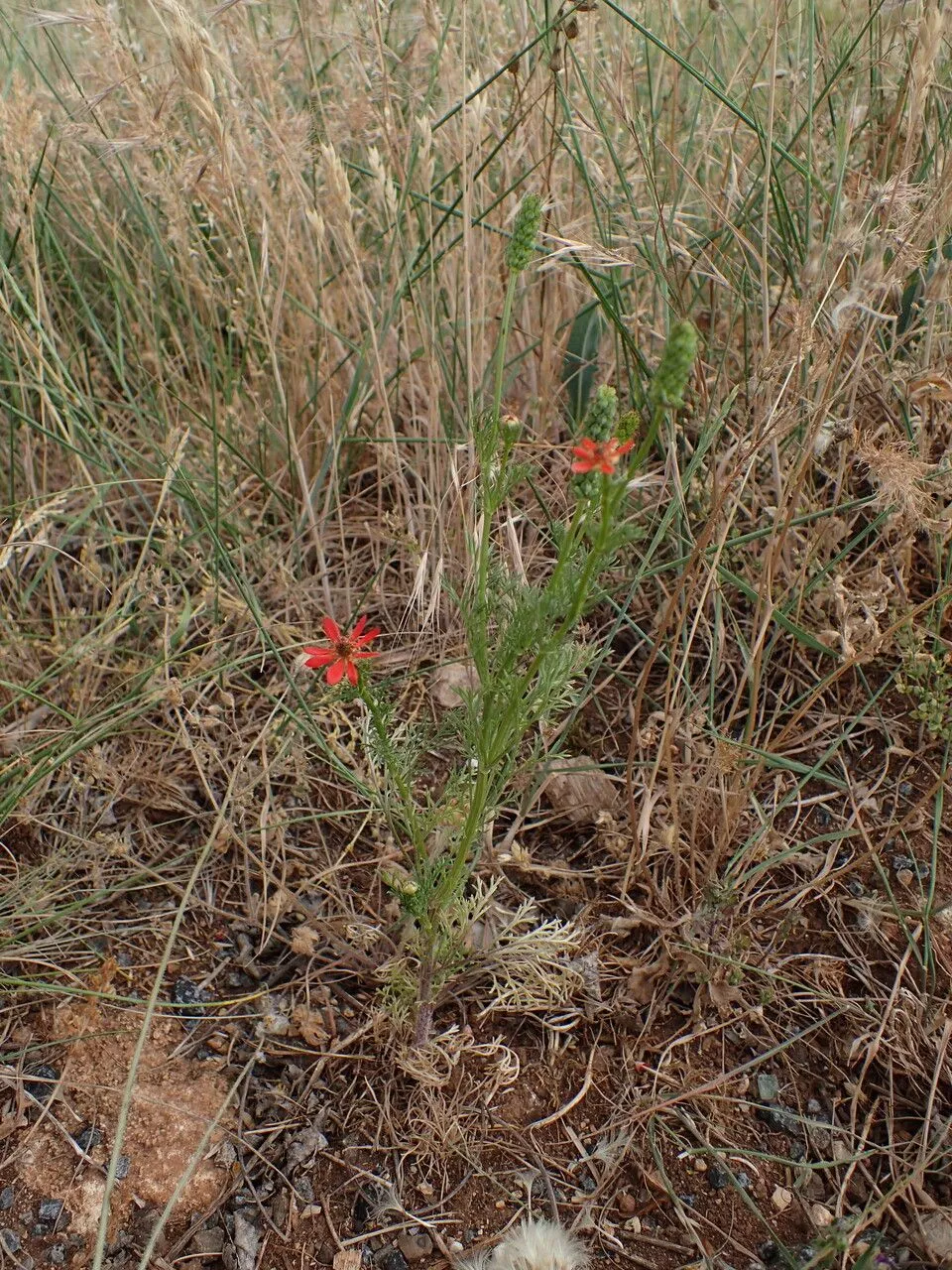
Author: Jacq.
Bibliography: Fl. austriac. 4:29. 1776
Year: 1776
Status: accepted
Rank: species
Genus: Adonis
Vegetable: False
Observations: Europe to NW. Iran, N. Africa
The Large Pheasant’s-Eye, scientifically known as Adonis flammea, is a captivating flowering plant belonging to the Ranunculaceae family. This striking plant, originally described by Jacq. in the Flora austriaca (4:29. 1776), is notable for its vibrant and fiery red blooms that offer a spectacle of color in its natural habitat.
Native to regions stretching from Europe to Northwestern Iran and parts of Northern Africa, Adonis flammea thrives in a variety of soil types and climatic conditions. It typically favors sunny, well-drained locations where it can make the most of the available sunlight to bolster its vivid displays.
The blooms of the Large Pheasant’s-Eye are particularly eye-catching. Each flower is composed of a multitude of delicate petals that come together to form a bright, crimson rosette. These blooms not only attract pollinators but also add a burst of color to meadows and wild landscapes, making the plant a favorite among natural gardeners and botanical enthusiasts.
In addition to its aesthetic appeal, Adonis flammea holds a certain mystique due to its historical context and wide geographical distribution. Its presence from the lush fields of Europe to the arid regions of Northwestern Iran and Northern Africa underscores its adaptability and the rich biodiversity of these locales.
Overall, the Large Pheasant’s-Eye is a plant that combines beauty, resilience, and an intriguing horticultural history, making it an invaluable addition to both wild habitats and cultivated gardens alike. Its radiant flowers and wide-ranging growth make it a symbol of nature’s splendor and diversity.
Deu: flammen-adonisröschen, flammendrotes adonisröschen
Swe: eldadonis
Eng: large pheasant’s-eye
Pol: milek szkarlatny
Nld: kooltje-vuur, kooltje vuur
En: Large pheasant’s-eye, Flame adonis, Large pheasant’s eye, Scarlet pheasant’s eye
Ar: أدونيس لهيبي
Az: Alovlu xoruzgülü
Be: Адоніс палымяны
Bg: Огнен горицвет
Cs: Hlaváček plamenný]
Nl: Kooltje-vuur, Kooltje vuur, Kooltjevuur
Fr: Adonis couleur de feu, Adonis écarlate, Adonis flamme, Goutte-de-sang rouge vif, Goutte de sang rouge vif
De: Brennendes Adonisröschen, Brennendes Feuerröschen, Brennendes Teufelsauge, Brennendrotes Teufelsauge, Flammen-Adonisröschen, Flammenadonis (dated), Flammenadonisröschen, Flammendrotes Adonisröschen, Flammen-Blutströpfchen, Scharlachtrotes Blutströpfchen
It: Adonide scarlatta
Ml: അഡോണിസ് ഫ്ലേമിയ
Fa: چشم خروس آتشین
Pl: Miłek szkarłatny, Milek szkarlatny
Ru: Адонис пламенный
Sk: Hlaváčik plamenný
Es: Ojo de perdiz
Sv: Eldadonis
© copyright of the Board of Trustees of the Royal Botanic Gardens, Kew.
© copyright of the Board of Trustees of the Royal Botanic Gardens, Kew.
© copyright of the Board of Trustees of the Royal Botanic Gardens, Kew.
Taken May 30, 2007 by Tela Botanica − Marie-France PACAUD (cc-by-sa)
Taken Jun 10, 2011 by Tela Botanica − Marie PORTAS (cc-by-sa)
Taken May 20, 2016 by Tercie Kadan (cc-by-sa)
Taken May 20, 2016 by Tercie Kadan (cc-by-sa)
Taken Apr 6, 2018 by Şule Kuzpınarı (cc-by-sa)
Taken Jun 10, 2018 by Tela Botanica − Jean-Claude Bouzat (cc-by-sa)
Taken Jun 10, 2011 by Tela Botanica − Marie PORTAS (cc-by-sa)
Taken May 27, 2015 by Tela Botanica − Marie PORTAS (cc-by-sa)
Taken Jun 3, 2015 by Tela Botanica − Jean-Claude CALAIS (cc-by-sa)
Taken Jun 6, 2022 by Sylvain Piry (cc-by-sa)
Taken Apr 15, 2012 by Photoflora – Jean-Luc TASSET (©)
Taken Apr 15, 2012 by Photoflora – Jean-Luc TASSET (©)
Taken May 31, 1854 by Tela Botanica − Herbier PONTARLIER-MARICHAL (cc-by-sa)
Taken Jun 5, 2014 by Tela Botanica − Marie PORTAS (cc-by-sa)
Taken Jun 6, 2022 by Sylvain Piry (cc-by-sa)
Taken Jun 6, 2022 by Sylvain Piry (cc-by-sa)
Taken Jun 5, 2022 by Patrice Bracquart (cc-by-sa)
Taken Jun 3, 2015 by Tela Botanica − Jean-Claude CALAIS (cc-by-sa)
Taken May 23, 2010 by Tela Botanica − Marie PORTAS (cc-by-sa)
Taken May 7, 2016 by Tela Botanica − Liliane ROUBAUDI (cc-by-sa)
Taken Apr 15, 2019 by Gómez Adrián (cc-by-sa)
Taken May 11, 2019 by Tela Botanica − Flora Zura (cc-by-sa)
Taken May 8, 2005 by Andrew Gagg (cc-by-sa)
Taken May 13, 2022 by Alain Lagrave (cc-by-sa)
Ph maximum: 9.0
Ph minimum: 8.0
Light: 8
Atmospheric humidity: 3
Bloom months: [‘may’, ‘jun’, ‘jul’]
Soil nutriments: 5
Family: Myrtaceae Author: (F.Muell.) K.D.Hill & L.A.S.Johnson Bibliography: Telopea 6: 402 (1995) Year: 1995 Status:…
Family: Rubiaceae Author: Pierre ex A.Froehner Bibliography: Notizbl. Bot. Gart. Berlin-Dahlem 1: 237 (1897) Year:…
Family: Sapindaceae Author: Koidz. Bibliography: J. Coll. Sci. Imp. Univ. Tokyo 32(1): 38 (1911) Year:…
Family: Asteraceae Author: A.Gray Bibliography: Pacif. Railr. Rep.: 107 (1857) Year: 1857 Status: accepted Rank:…
Family: Fabaceae Author: Medik. Bibliography: Vorles. Churpfälz. Phys.-Ökon. Ges. 2: 398 (1787) Year: 1787 Status:…
Family: Aspleniaceae Author: (Cav.) Alston Bibliography: Bull. Misc. Inform. Kew 1932: 309 (1932) Year: 1932…